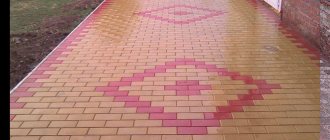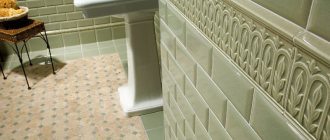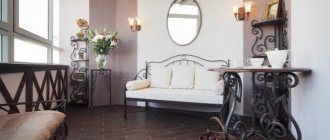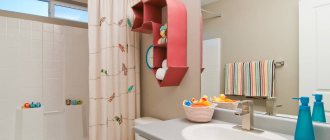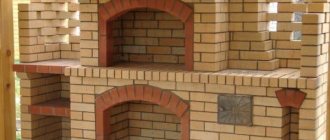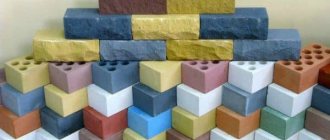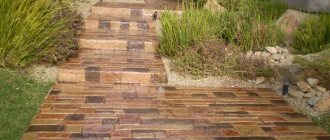Leroy – decorative brick for interior decoration
Today, decorative bricks for decoration inside a room are actively used by people who wish to transform a room in a house, office or city apartment.
The reason for such success of this building material is that it is absolutely natural, has natural beauty and is environmentally friendly. Using this material, you can give life to even the most extraordinary and intricate ideas. Today there is a wide range of products available for interior cladding. Each type of material has its own characteristics and scope of application.
Plaster
At its cost, this material can be called the most affordable. The process of its production is very simple, and gypsum is used as the material. The final product is coated with a paint and varnish composition, making it no different from its counterparts.
The photo shows gypsum bricks for interior decoration:
Gypsum brick is practical, durable and resistant to temperature changes. But you should not use gypsum in rooms where there is high humidity - kitchen, bathroom. It can be used when decorating a living room or corridor. Its cost is 880 rubles per m2.
Porcelain tiles
This stone is distinguished by its high strength characteristics. The process of obtaining it occurs using a special technology. Crushed granite is placed into the clay mixture, then it is pressed.
Made from porcelain stoneware, it is distinguished by its strength and durability. It can be used when decorating an arch in the corridor, for the kitchen and bathroom. The cost of stone in Leroy Merlin is 2200-2800 rubles per m2.
Ceramics
Ceramic decorative bricks for finishing interior space are no different from finishing bricks. The only thing that distinguishes them is thickness. The material is produced by high-temperature firing, to which the clay mixture is subjected.
Various binding components are placed in it. Used for finishing bathrooms, kitchens and toilets. Its cost is 18 rubles per piece.
Under the stone
This material allows you to give the room a noble aristocratic look. It is used when cladding a hallway or living room.
Finishing with decorative bricks to look like stone is no different from facing with real stone, but it costs less, and the installation process is simpler. The cost is 1800 rubles per m2.
Clinker brick
This material belongs to the most expensive category. In its manufacture, a material such as clay is used. A high price indicates high quality and its properties. During the production of the material, the brick was fired, due to which it has high density and reliability. By firing it is possible to obtain a heterogeneous color range.
Clinker bricks are characterized by a smooth surface. Used primarily for finishing English-style kitchens. In this case, the cladding can be completed completely. For a spacious kitchen space, it is advisable to use white clinker bricks.
The material can be used not only for internal, but also external cladding. Inside the house, clinker bricks are used in those rooms where there is a temperature difference.
These are loggias, verandas, fireplaces and chimneys. To decorate the apron of the work surface in the kitchen, you need to use smooth clinker material. This part needs wet cleaning, which is associated with increased friction. It is unacceptable to use gypsum bricks here. The cost is 3500 rubles per 1 m2.
And for those who want to understand how many one-and-a-half bricks are in a pallet, the information from the article will help you understand.
What is lime mortar for bricklaying and how it can be made is described in this article.
For those who want to know how much red solid brick weighs, you should follow the link and look at the contents of the article: https://resforbuild.ru/kirpich/kladochnyj/ves-kirpicha-krasnogo-polnotelogo-250x120x65.html
But what are the dimensions of a solid brick m 150 and what it looks like, you can understand by looking at the contents of the article photo.
Color and places of application in the interior
Decorative brick in the interior of the hallway is the most optimal solution for decorating this part of an apartment or private house, capable of giving an original and natural design. Arches or columns in the hallway lined with decorative stone, if any, will perfectly decorate its interior. Since this room serves as a kind of face of the house, a place where guests are welcomed, by using decorative brick in its interior, the owner will be able to pleasantly surprise those who decide to visit him. The use of such material in the hallway depends on the creative imagination of the homeowner. You can decorate an entire wall or just a separate fragment in this way. Using different shapes and colors of this material, it is possible to create a special design that will create a pleasant and cozy atmosphere in the hallway.
Decorative brick in the interior of the hallway photo
Since decorative brick is an excellent natural material, its use in interior decoration is becoming increasingly popular among property owners. Decorating the interior with the help of such material is possible in every room of an apartment or house. Using similar decoration in the kitchen interior, you can separate the area where the dining table is located. Against its background, you can place kitchen furniture, decorate columns and other areas of the kitchen space.
Decorative brick in the kitchen photo
The color of decorative bricks is selected according to the size and lighting of the kitchen. If the kitchen is small, then it is better to use light colors, since dark brick will make the room visually smaller. The same applies to a poorly lit kitchen when the windows do not face south. But in large rooms you can use dark colors of decorative bricks; they will have a pleasant effect on demarcating the territory, highlighting separate zones. A separate work space is allocated where the housewife spends most of her time - usually this is how she decorates and at the same time creates a kitchen apron. Here the material needs to be selected, taking into account the taste of the woman who will have to admire the interior of this part of the kitchen all the time.
As for decorating the bedroom interior, here you also need to approach it purely individually. Decorative white brick in the interior of this part of the apartment will slightly increase the space and make the bedroom brighter.
Decorative white brick in the interior photo
But the use of dark tones of finishing material will give this room some mystery and originality. This bedroom evokes more romantic moods. For example, the red color at sunset looks amazing on the wall. Therefore, red brick in the interior looks very impressive.
Red brick in the interior photo
The choice of decorative brick color depends on the taste of the home owner. But still, it won’t hurt to consult an interior designer when performing finishing work. Decorative bricks for interior decoration must match the color of the overall interior of the room. Most often, consumers choose natural colors of the material. In any case, decorative elements of interior decoration should fit perfectly into the overall interior of the living space, and not stand out against its background - if such a task is not necessary. To choose the right color, it is necessary to take into account the opinions of all family members, as well as be guided by the area of the rooms and their level of lighting. Decorative decoration should pleasantly please residents, and not irritate them.
Decorative brick finishing photo
Types of brick tiles
Concrete facade tiles
Due to their characteristics, concrete-based tiles are suitable for cladding facades and basements. Sometimes it is also used for interior decoration, but this is not entirely advisable: more affordable analogues perform this role well. This tile has the following characteristics:
- water absorption: from 4%;
- frost resistance: up to 200 freezing and thawing cycles;
- density: up to 2500 kg/m3.
Pros:
- durability even when used outdoors;
- satisfactory moisture resistance;
- resistance to temperature changes.
Minuses:
- may have a lot of weight, which will require strengthening the foundation.
Gypsum tiles
Gypsum brick tiles are used only indoors. Moreover, it should not be placed in the kitchen or bathroom: finishing with gypsum brick tiles does not withstand temperature changes and contact with water. This is the most unreliable, but at the same time affordable way to reproduce the texture of hand-molded brick.
- water absorption: from 7%;
- frost resistance: up to 50 cycles of freezing and thawing;
- density: up to 1250 kg/m3.
Pros:
- light weight;
- simple installation;
- good sound insulation.
Minuses:
- fragility;
- low moisture resistance;
- sensitivity to temperature changes.
Ceramic tile
Most often used for interior work. There are varieties of tiles designed for façade cladding, but they may be inferior to concrete or porcelain stoneware in terms of durability. The fact is that ceramic tiles, which are made from a mixture of clay and mineral components, are characterized by hygroscopicity: they absorb moisture, which, in turn, deforms the structure of the material.
Pay attention to the main characteristics of brick-like ceramic tiles:
- water absorption: from 6%;
- frost resistance: up to 60 freezing and thawing cycles;
- density: up to 1700 kg/m3.
Pros:
- durability for indoor use;
- easy care.
Minuses:
- low moisture resistance;
- sensitivity to temperature changes;
- sensitivity to mechanical stress - shock or pressure.
You may find it useful
Sand-lime facing brick: photos, characteristics, advantages and disadvantages
Sand-lime bricks are also materials that are made without resorting to the firing process. But this brick differs from the previous version in the components that make up it. First of all, no cement is added to the raw material at all. The desired strength of the material is achieved by hardening silicate sand mixed with slaked lime. To stimulate this process, they resort to using an autoclave unit, which provides increased pressure and temperature.
Today this material is not particularly popular as a facing material. First of all, this is due to its appearance. Despite the fact that manufacturers have nevertheless developed several color solutions, they all do not look too bright or attractive. So in the fight against ceramic or clinker bricks, silicate bricks definitely lose.
Sand-lime facing bricks are produced without firing procedure
But if we talk about the positive aspects of this choice, then the technical characteristics of this material are more than satisfactory. On the one hand, silicate elements are somewhat more susceptible to moisture absorption than clinker elements, on the other hand, they are better able to withstand the effects of repeated wetting, freezing and thawing.
Helpful advice! In order to choose a brick that is suitable in color, texture and shape, it is not at all necessary to spend the whole day visiting construction stores. The easiest way is to go to the website of a reliable supplier, and using the Internet catalog, choose the best option.
Artificial decorative brick
Artificial decorative brick for the interior is an imitation of natural material.
As a rule, products are made on the basis of gypsum mass and plasticizers, by pouring it into special molds. The front side of the products performs a decorative function, and the back side, to facilitate the installation process, is completely smooth.
There are no clear standards for the production of artificial bricks yet, and therefore manufacturers today offer a lot of options for their products. Depending on the planned project, you can choose artificial bricks of different shapes:
- figured,
- rectangular,
- rounded,
- trapezoidal,
- wedge-shaped.
The color solutions of the material will be limited only by your imagination. But the more popular are those shades that resemble natural ones - beige, terracotta. Externally, the products have very different textures. Today you can buy decorative bricks for the interior that are completely smooth, chopped or embossed.
Artificial decorative brick, while completely similar to natural material, is thin and light. Therefore, it is extremely easy to install, which is what captivates many buyers. Entire walls and individual panels are laid out of the blocks, and doorways and arches are lined with them.
To create a unique interior, you just need to choose the right material. And since the imagination of craftsmen has no limits, the consumer ultimately sees a lot of options on the shelves of construction stores. Manufacturers offer a variety of product series.
For example, aged decorative brick is perfect for recreating certain thematic interiors right in your apartment. The series is represented by many manufacturers in the following collections of products:
- Manhattan,
- Chester,
- Brooklyn,
- Prague.
Sand-lime facing brick: photos, characteristics, advantages and disadvantages
Sand-lime bricks are also materials that are made without resorting to the firing process. But this brick differs from the previous version in the components that make up it. First of all, no cement is added to the raw material at all. The desired strength of the material is achieved by hardening silicate sand mixed with slaked lime. To stimulate this process, they resort to using an autoclave unit, which provides increased pressure and temperature.
Today this material is not particularly popular as a facing material. First of all, this is due to its appearance. Despite the fact that manufacturers have nevertheless developed several color solutions, they all do not look too bright or attractive. So in the fight against ceramic or clinker bricks, silicate bricks definitely lose.
Sand-lime facing bricks are produced without firing procedure
But if we talk about the positive aspects of this choice, then the technical characteristics of this material are more than satisfactory. On the one hand, silicate elements are somewhat more susceptible to moisture absorption than clinker elements, on the other hand, they are better able to withstand the effects of repeated wetting, freezing and thawing.
Use of polystyrene foam
In the process of decorating walls, you can use decorative bricks for finishing measuring 150x70x(5-10) mm or 250x65x(5-10) mm, made of foam plastic. To do this, mark the sheets of material with a regular gel pen, taking into account possible indentations on the seams.
Then, using a knife or a sharp cutting object, various effects can be depicted on the surface of the bricks - cracks or irregularities. To do this, use a heated soldering iron. Painting should be done using water-based paint and other solvent-free compounds.
The cladding can be done using regular wallpaper or tile adhesive, PVA. First, the first level is attached along the bottom edge. There should be gaps between the bars.
Styles Suitable for Brickwork
Seys lined with brick look most successful in the following styles:
- Loft. This style differs from the others in that it almost completely replicates the interior of old factories, storage and production facilities. That is, this is a kind of industrial design. Brick can occupy all the walls in such a room. It must be combined with other elements - beams, hanging ropes, twisted wiring in an old winding.
- Minimalism. An urban movement that tries to combine the incompatible. Therefore, decorative masonry is often presented in bright colors. Only one wall is covered with it, which is opposed to the rest. They are available in gray or white colors.
- Country. The style is responsible for the creation of a country house, where decorative facing brick appears for the interior decoration of the walls, which are a continuation of the fireplace. We need to try to achieve distance from urban housing, to create a cozy primitiveness.
- Gothic (neo-Gothic). Masonry is laid literally everywhere, but in combination with other contrasting interior objects. Premises for this style should have high ceilings.
Most often, decorative brick is used to decorate loft-style interiors.
Decorative brick options
Numerous materials can become the basis for decorative bricks. The variety of choices allows you to choose the appropriate cladding option for each specific room in order to highlight its strengths and hide its shortcomings.
The following options are widely used:
- Gypsum imitation brick. In appearance it is difficult to distinguish it from natural material, but it is much lighter and does not create additional load on the surface, which also increases its strength and prevents collapses. Gypsum brick looks original, and it is also versatile and suitable for decorating both classic and more modern interiors.
- Foam brick. It is lightweight, which reduces the load on the walls. One of the most affordable design options.
- Polyurethane brick. A practical and durable option that allows you to easily transform even an outdated interior. Polyurethane absorbs sound well, resulting in additional heat and sound insulation of the room.
- Clinker tiles. This type of material is used primarily for lining stoves and fireplaces. It withstands high temperatures well and has good performance characteristics (its properties are closest to traditional brick).
Different options for decorative bricks are distinguished not only by their appearance, but also by their operational features.
Decorative brick in the form of clinker tiles
Quite a heavy material that is rarely used for cladding walls and partitions. But when decorating stoves, fireplaces and chimneys, clinker tiles are simply irreplaceable. On walls it can be used as an accent to highlight specific areas. The main advantages that clinker tiles have as a facing material:
- Good moisture absorption performance. Material of this type can be used to decorate rooms with high humidity - kitchens, bathrooms, toilets, showers (including public ones). Moisture resistance indicators also make it possible to use clinker tiles for external cladding of buildings and facades.
- The product is made from environmentally friendly materials, making it suitable for use in residential areas.
- Resistance to temperature changes, including critical ones.
- Wear resistance and strength.
- Lack of reaction to various chemicals. The surface of clinker tiles can be treated with various compounds without any problems.
When choosing clinker tiles, you should pay attention to the variety of its shades - there are options in both matte and glossy versions, which will definitely find their application in the interior or exterior of the room.
Decorative gypsum brick
Gypsum is a traditional material for making lightweight and durable decorative products. It is distinguished by its affordable price among similar cladding options, environmentally friendly (one might say impeccable) composition, as well as a variety of not only shades, but also options for finishing corners. Some features of decorative gypsum bricks:
- Despite excellent performance indicators, the material has low hygroscopicity, which is why it is not suitable for use in rooms with high humidity.
- To work with gypsum, a special adhesive composition on a similar basis is required (to achieve maximum adhesion to the surface).
- To create a single, airtight seam, the use of grout is required.
In some stores you can find options for gypsum bricks with an additional moisture-proof layer. In this case, it is necessary to select an adhesive composition for working with complex substrates.
Decorative brick made of polyurethane
The material has a brick relief, which in appearance makes it almost indistinguishable from traditional brick. Polyurethane itself is resistant to high humidity (suitable for cladding bathrooms, toilets, showers), and also provides reliable heat and sound insulation of rooms, which makes it indispensable when arranging balconies, terraces, loggias (including when turning them into full-fledged work or residential areas). Attaches with liquid nails or acrylic glue. It is polyurethane brick that has the greatest variety. The main options that you can find:
- Acrylic. Stylish, practical, durable. Decorative brick made of acrylic is distinguished by its lightness, almost weightlessness, as well as a wide selection of shades and textures.
- Ceramic. In terms of performance characteristics, it is similar to ceramic tiles, which are traditionally used when decorating rooms with high humidity - kitchens, bathrooms, toilets.
- Porcelain stoneware. The most expensive, but at the same time the most durable option. The composition includes natural granite chips, which makes the material resistant to mechanical damage and most external factors.
Decorative foam brick
When decorating the external or internal facades of a building, you can even find finishing materials made of foam plastic. Their main advantage is their lightness, which minimizes the load on the walls. Foam bricks are usually used to design partitions that do not have load-bearing capacity. The process of laying the material looks very simple:
- Blocks of suitable size are cut out of polystyrene foam using a stationery knife (careful measurements should be taken before doing this).
- The resulting blocks are laid on the surface and secured with liquid nails.
- The top is covered with water-soluble paint.
Since foam structures are coated with water-soluble paint, such material cannot be used when decorating rooms with high humidity. It is also not able to withstand high loads and performs a purely decorative function.
Description of gypsum
Gypsum decorative bricks for interior decoration also have high-quality technical characteristics, but they cannot be used for exterior use.
By purchasing such a stone, you receive:
- high level of reliability;
- durability of the finish;
- practicality in installation and operation;
- decorative gypsum bricks for interior decoration have a wide range of different sizes and come in a variety of colors;
- resistant to temperature changes.
Many people know that gypsum tends to absorb moisture, which can cause the base to deteriorate and become deformed. So the technology contains an additional layer of protection; varnish is usually used. At the same time, protection helps not only prevent moisture absorption, but also increase the range and quality of the coating.
Plaster
Thanks to the varnish, a matte, glossy, embossed surface is achieved. Additionally, there are effects of convexity or concavity and a feeling of a torn surface.
The size of ordinary decorative bricks for interior decoration can be very diverse; many manufacturers, at their own discretion, provide a choice of shapes and sizes.
It is worth noting that purchasing a brick is not necessary; it is possible to prepare it manually.
The process is quite simple and looks like this:
- The dough is prepared from gypsum , usually bought in a store. You just need to pour in the powder and add warm water to it, the proportion is indicated on the packaging of the specific material;
- preparing molds, these can be any desired shapes and sizes of bricks. There are certain options even on sale;
- the mold is first lubricated with fat and a thickener is added to the mixture;
- it is necessary to pour the gypsum solution into the mold and add pigment to it, mix the mixture;
- For a pleasant visual effect, you can add several colors to the solution and mix a little so that streaks remain. You can mix until smooth. In this case, it is better to use a mixer so as not to fuss for a long time;
- The mixture is set aside until it hardens. Typically, the process of acquiring the required strength occurs within 24 hours;
- to remove the tiles from the molds without damaging them, you must use a rubber hammer;
- Immediately after receiving the gypsum brick, it should be opened with varnish to prevent damage during the installation process.
If you buy the material in a store, the cost of 1 m2 of brick will start from 600 rubles. Usually this includes about 80 pieces measuring 217 x 65 x 8 mm.
What is the size of facing brick according to GOST?
As mentioned above, the dimensions of different types of facing bricks (both ceramic and clinker, and silicate and hyper-pressed) are standard. But at the same time, the material is divided into several types according to size.
Domestic standards specify the following product formats:
Single
(1NF, Fig. 1) – 250×120×65 mm.
Figure 1. Dimensions of a single brick
One and a half
(1.4NF, Fig. 2) – 250×120×88 mm.
Figure 2. Dimensions of one-and-a-half products
, euro facing bricks are in great demand.
(0.7NF, Fig. 3), the height and length of which are similar to the standard one, but the width is different - instead of 120 mm it is 85 mm. This allows you to significantly save on cladding, which is especially important if clinker products are used as the material.
Facing brick
The size of a single facing brick is the same as that of an ordinary brick. The difference lies not in size, but in quality requirements. Products intended for facing masonry must have increased frost resistance and resistance to mechanical damage. Therefore, a different mixture is prepared for them, if we are talking about ceramics, and one spoon and pokes are covered with glaze. Sand-lime brick, which is made from lime and sand by pressing and autoclaving, does not need this.
Most types of ceramic and silicate suitable for facing masonry are hollow. Solid bricks are also used, for example, clinker or some types of silicate.
What to pay attention to
Despite the fact that there is a standard for the size of facing bricks, you should be careful when calculating its quantity per masonry.
This is due to the fact that the equipment in brick factories is old, quality control is poor, and deviations from standard sizes are a frequent occurrence. The currently fashionable facing material of yellow, red and brown colors with different surface textures looks great, but its sizing is a sore spot.
Its length ranges from 248 to 253 mm, width - from 118 to 122, height varies within 2 mm, but sometimes this is critical: masonry made from it looks good on a thin seam. When a mason tries to evenly distribute the bricks throughout the masonry , in some cases the jointing does not fit into the seam, and in others the mortar fails. Recessed rectangular seams (so-called bar laying) only partly solve this problem. Products of different sizes may appear in the same batch.
There is a variation in height for one-and-a-half (widened) sand-lime bricks. With a standard height of 88 mm, it is found in both 85 and 92 mm. Moreover, on opposite spoon surfaces, these dimensions may differ for one individual product.
Way out
Today, such types of facing masonry as three- and six-row, masonry with diaphragms, double cross and Gothic, when dressing is carried out on a quarter of the brick, have lost popularity. This is partly a consequence of the fact that the material for masonry walls is increasingly becoming ceramic stone and large-sized blocks, and when they are capable of being combined with facing masonry, both masons and designers are simply too lazy to do this.
Therefore, the main type of brick cladding has become chain masonry with half ligation, when length matters. To avoid getting into an unpleasant situation, it is advisable to measure samples from different pallets and identify the difference, and then lay them out dry. This will help maintain the average thickness of the vertical seam if you do not move the brick to the side in subsequent rows.
The difference in height can be controlled using an order or a simple tape measure.
Dimensions of decorative bricks
For those who wish to use decorative brick tiles in cladding, it is worth understanding that cladding is available in various formats. So, if this is cladding for interior decoration, then most often the tiles have the dimensions of standard bricks. That is, the height of the tiles can vary from 6 to 15 cm, the length of the tiles varies in the range of 16-24 cm, and the thickness of the facing stones is invariably 2-2.5 cm.
If it is intended to use facade finishing, then to facilitate the work, the craftsman is offered decorative finishing bricks in the format of panels. Such fragments are easier and faster to install. The dimensions of such panels can vary between 320X340X25 mm; 380X200X25 mm, etc. (but strictly depending on the type of stone that imitates the panel).
Important: if decorative brick tiles imitate rocky stones, then here the dimensions may look different - 210x102x48mm. That is, the thickness of the stones will be greater, and their height will be less.
Clinker decorative facing brick: dimensions and characteristics
Clinker brick is in many ways similar to ceramic brick. But there are certain differences between them related to the characteristics of the raw materials and temperature conditions for firing. In order to make clinker bricks, predominantly medium-melting and refractory clays are used, so that firing, accordingly, requires higher temperatures.
Decorative facing bricks can be combined in texture and color, obtaining a unique appearance of the facade
The result of using this technology is a more durable facing brick, which is characterized by a minimal level of water absorption and excellent resistance to all kinds of external factors. Such characteristics allow it to be used not only for decorating the walls of a house, but also as a facing material for foundation plinths, paving paths and erecting fences.
But there are also indicators in which clinker brick is inferior to ceramic brick. For example, this concerns thermal conductivity, which in this case is slightly higher. True, this disadvantage is compensated by the fact that the material is characterized by a high level of resistance to cracking as a result of exposure to low temperatures.
The colors and textures of clinker bricks can be so diverse that you can even come across the concept of “collections” that various manufacturers offer their customers. As for the sizes of clinker bricks, here you can find a wide variety of options.
The standard size of decorative brick can have the following parameters - 250x120x65 mm, 250x90x65 mm and 250x60x65 mm. As you can see, the height of the brick can change, but the length and width of the brick remain unchanged. The only exception is the elongated elements, the parameters of which are 528x108x37 mm.
Dimensions of facing bricks
Features of the installation process
Concrete, brick, wooden and plastic surfaces are decorated with decor. The bricks are laid in a checkerboard pattern. This type of “masonry” is considered classic and looks impressive.
For installation work you will need the following tools and materials:
- glue;
- level;
- spatulas;
- plumb line;
- varnish;
- hacksaw;
- brush;
- construction gun for installation work.
The wall or other surface must be plastered and leveled. It is recommended to make grooves in the plaster that has not yet dried, which will ensure good adhesion of the adhesive materials. The gypsum masonry must be level, and for this, when laying the first row, use a plumb line and a perpendicular.
The glue is applied in an even layer on one side of the brick and on the wall. When performing seamless installation, excess glue must be removed immediately, without allowing it to dry. The method of laying with a seam requires the use of grout and special beacons.
The grout mixture should be grainy and sticky. At the end of the work, the seams are treated with an adhesive composition. The finished “masonry” must stick securely: you need to wait a few days before loading the wall with paintings, lamps and other decorative elements.
Related video: Making decorative bricks
Recommendations and methods for laying decorative bricks
The brickwork of decorative cladding material inside the building creates a separate aesthetic element that is a spectacular decoration of the interior. If this is done in a new house, then smooth brick walls are ideal for such cladding. But before carrying out facing work, old walls need to be cleaned of old coatings, dirt, and fragments of plaster must be removed.
It is necessary to observe such rules when facing with decorative bricks, such as space and light. With it you can give the interior a wide variety of styles. Everyone today can turn their home into princely chambers. Different shapes and a rich range of colors allow you to embody your wildest creative fantasies and refined tastes in your interior.
To fix the decorative cladding, special glue or liquid nails are used. The gaps between the bricks are sealed with a special grout. In the process of implementing a particular type of masonry, the brick is placed in the required order. Polish decorative masonry is widely used. It follows the order of placement of brick sides of different lengths in rows. In addition, Gothic and Russian masonry are known. Cross masonry is more complex and requires special skills in its implementation.
Decorative brick in the interior
To carry out any type of masonry, you will need the necessary tools, without which it is impossible to lay materials. Today, a special saw has found its application in such work. When facing, angular and planar types of decorative bricks are used. The material is glued to a hard and even surface. The back side of the material is treated with construction primer quite liberally. During installation, you need to move each brick a little in different directions for better adhesion to the wall, but you should not remove excess glue by pressing on the material.
